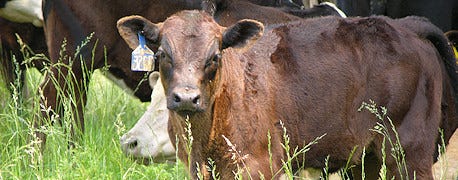April 26, 2012

NOTE: This article was prepared by Britt Hicks, Hicks is an area livestock extension specialist for Oklahoma State University.
Whether calves are castrated at birth or up to four months later doesn’t seem to matter.
A 2007-08 USDA survey of U.S. beef cow operations found that about 59.2% of operations castrated any bull calves prior to sale. The percentage of operations that castrated bull calves prior to sale increased as herd size increased:
50.3% -- herds of 1-49 cows
75% -- herds of 50-99 cows
85.1% -- herds of 100-199 cows
95.3% -- herds of 200+ cows
This same survey reported that most operations (74.5%) castrated bull calves at an average age of less than 93 days, but almost one of five operations (18.4%) did not castrate calves until they were over 122 days old.

Castration Timing Not Critical in Nursing Calves
It is well documented that castration of feeder calves on arrival or shortly after arrival at a feedlot decreases daily gains and increases morbidity. As a result, when purchasing feeder calves, bulls are typically discounted relative to steer calves.
Recent Kansas State University research focused on evaluating the effects of castration on calves that are castrated post-arrival relative to those castrated before arrival and estimating appropriate discounts for bull versus steer calves.
Data on 3,380 male calves -- 2,197 bulls and 1,183 steers -- used in 11 receiving trials from March 2006 to October 2008 was analyzed. This analysis showed that surgical castration of calves after arrival reduced daily gains by 9.6% or 0.35 pound/day, compared with steers over a 44-day receiving period.
These researchers reported that based on 2009 market conditions, bulls should be discounted at feeder-calf sales, compared with steers. At the average arrival weight in these trials of 461 pounds, bulls should be discounted $4.99/cwt. relative to the same body-weight steers. The discount increased to $5.44/cwt. for 375-pound calves and decreased to $3.63/cwt. for 551-pound calves.
These discounts are similar to the $6.31/cwt. discount recently reported by University of Arkansas researchers in which data was collected from 14 Arkansas auction barns in 2010 on 38,346 lots consisting of 79,822 head.
Recent University of Florida research also investigated whether timing of castration in nursing calves affected calf performance and weaning weight. In their study, 93 Angus and Brangus calves were either surgically castrated early at an average age of 36 days or late at an average age of 131 days. The age of the early castrated calves ranged from 3 to 73 days and the age of the late-castrated calves ranged from 84 to 180 days.
At the time of castration, the average body weight of the late-castrated calves was 356 pounds. Calf birth weights were similar between treatments at about 80 pounds. Performance attributes were all similar between early and late castrate treatments, respectively:
Actual weaning weight -- 456 vs. 452 pounds
Adjusted 205-day weaning weight -- 512 vs. 504 pounds
Average daily gain from birth to weaning – 2.0 vs. 1.92 pounds
In summary, no differences in early and late castration were observed in this trial. These researchers concluded this data indicates producers have some degree of flexibility in determining when to implement castration.
The data showed castration at or near birth did not have a detrimental effect on calf performance or weaning weight. These authors also suggested that producers should realize that delaying castration until calves are approximately 131 days old will not bring added weight at weaning despite some producer philosophies and marketing claims that endorse such management practices.
You May Also Like




